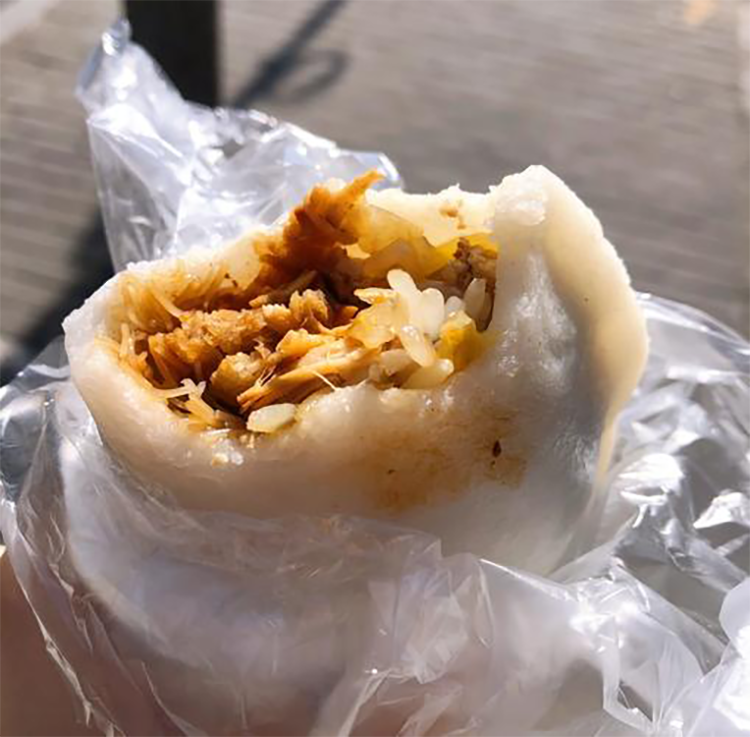Wenling Qiangao: Taizhou’s Giant Stuffed Rice Cake
In Wenling, Taizhou, mornings come alive with a handheld treasure: a plump, dumpling-shaped rice cake called Wenling Qiangao. With a soft, chewy glutinous rice skin and a rich mix of savory fillings, it’s a beloved local breakfast and a must-try Taizhou street food for travelers seeking authentic flavors.
1. Origin and History: From Home Wisdom to a Street-Star Snack
Wenling Qiangao grew from the coastal rice culture of Taizhou. Local families turned steamed glutinous japonica rice into a malleable cake, then used leftovers as fillings—an efficient, tasty way to avoid waste and feed sailors, fishermen, and farmers. Over time this practical home dish moved to market stalls and became a signature local snack, carrying memories of frugality and daily life in Wenling.
2. Cultural Meaning: Comfort Food and a Morning Ritual
In Wenling, Qiangao is more than breakfast. It’s a greeting and a comfort for people away from home—”Have you eaten Qiangao?” is a common morning exchange. The cake reflects Taizhou’s practical but refined approach to food: ordinary ingredients combined cleverly to create a satisfying, ritualized daily treat.

3. Ingredients and Flavor: A Symphony of Textures
A great Qiangao balances its rice skin and fillings.
- Skin: Made from freshly harvested japonica rice soaked, steamed, and repeatedly pounded to achieve a soft, elastic, slightly chewy texture—more tender than regular rice cake but chewier than glutinous rice alone.
- Fillings: The hallmark is abundance. Typical fillings include stir-fried rice noodles (fen gan), shredded carrots and potatoes, crisp cabbage, braised pork or pork belly, and shredded egg. Vendors may also offer fried dough sticks (youtiao), tofu sheets, pickles, and onions. The savory braise soaks into the rice skin while vegetables add crunch, creating layered flavors and textures.
4. Watching It Made: Street-Cooking as Performance
Seeing a master make Qiangao is part of the experience. The vendor takes a warm, white mound of rice dough, rolls it into a round, piles chosen fillings in the center, then deftly lifts and pinches the edges together into a plump dumpling shape. Some sellers will cut the cake into sections for easy handling, revealing a colorful cross-section that makes it even more tempting.

5. Tasting Tips and How to Eat It Like a Local
Eat Qiangao fresh and hot to enjoy the full contrast of textures.
- Best companions: Pair it with a bowl of savory tofu pudding (salty doufu nao) or mung-bean noodle soup. Dip a bite in the broth or alternate sips and bites to balance richness and warmth.
- Eating technique: Bite from the side so you get both skin and all fillings in one mouthful. Be careful—hot filling can burst out, but that’s part of the fun.
6. Traveler Tips: Order and Timing Like a Local
- Where to go: Skip polished cafes; look for breakfast stalls or long-standing shops favored by locals around the old town and wet markets.
- Ordering lingo: Say “One Qiangao, please,” and specify fillings—e.g., “extra braised pork” or “no onions.” Saying the local name “jiagao” (dialect:) adds authenticity.
- Best time: Breakfast hours from about 6:00–10:00 a.m. Many stalls sell out by noon.
- Cost: Affordable—typically 10–20 CNY depending on fillings.

7. Home-Style Shortcut: Recreating Wenling Qiangao
If you miss it after traveling, try a simplified home version.
- Skin substitute: Use store-bought hot-pot rice cake slices, steam until soft, then knead and roll while warm to mimic the texture.
- Fillings: Shred and quickly stir-fry carrots, potatoes, and cabbage; braise pork in soy and spices; make a thin egg crepe and shred it.
- Assembly: Place fillings in the center of the warmed rice sheet and pinch closed like a dumpling. It won’t be identical, but it captures the comforting flavors.
8. Conclusion
Wenling Qiangao looks humble but reveals Taizhou’s coastal culture and resourceful cuisine. More than a snack, it’s a savory postcard of local life—perfect with a hot bowl of soup and an invitation to start the day like a Wenling local. If you stroll Taizhou’s streets, stop for one: its warm, layered taste will likely become a lasting travel memory.


